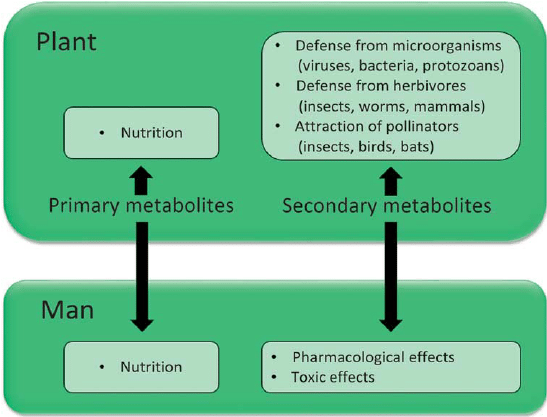Plants are one of the most successful forms of life on earth, despite their inability to move about. Since they can’t flee inhospitable conditions, they have evolved numerous physical and biochemical coping mechanisms, enabling their own pollination and seed dispersals, combating variations in climatic conditions, deploying herbivore deterrents, creating barriers to pathogen invasions, and mitigating biotic and abiotic stresses.
Primary metabolites are involved in nutrition and the basic essential metabolic processes inside the plant. Secondary plant metabolites help the plant adapt to changing conditions. Secondary metabolites may also inhibit the growth of competitor plants (allelopathy). Pigments (such as terpenoid carotenes, phenolics, and flavonoids) color flowers and, together with terpene and phenolic odors, attract pollinators. It makes sense for growers to promote the production of secondary metabolites to naturally make the plant more “bulletproof.”
The accumulation of secondary metabolites is highly dependent on environmental factors such as light, temperature, soil water, soil fertility, and salinity. While we have only limited control over light and temperature, we can still influence photosynthesis, water, fertility, and salinity. Plants produce over 100,000 varieties of secondary compounds that serve as tools to keep them alive and thriving. The main categories of secondary metabolites are terpenes and terpenoids, phenolics, and alkaloids. Compounds are grouped into one of these categories based on their chemical structure.
These compounds are found throughout nature and in most plants. For example, essential oils isolated from rose, peppermint, lemon, and lavender contain numerous secondary metabolites like oxygenated monoterpenes, aliphatic compounds, and aromatics that give these oils their uniquely pleasant fragrance. It’s interesting to note that every human cell has an olfactory receptor that bypasses the thalamus area in the brain. The thalamus itself is composed of different cells that each serve a unique role, ranging from relaying sensory and motor signals, to the regulation of consciousness and alertness. Maybe that’s why we are so affected by fragrances.
Other non-aromatic terpenes and higher molecular weight terpenes can act as protective compounds, providing the plant with a bitter taste, pungent aroma, or sticky texture to repel potentially harmful predators. Phenolics offer many benefits to the plant and have additional applications to human health and wellness. Included in phenolics are lignin, flavonoids, and tannins.
It’s important to tie plant health with our own health. For example, the production of secondary metabolites from plant cells is being used to develop antioxidants or anti-inflammatory, antimicrobial or antibiotic drugs, and anti-diabetic drugs. The pressure to discover and develop new and effective anti-infectious substances has grown due to the intensification of new and reemerging infectious diseases as well as the increasing microbial resistance to antibiotics in current clinical use. It’s fascinating that these treatments are similar to how secondary metabolites aid in the plant’s survival. When we ingest those secondary metabolites, they affect our cells and body systems, offering the support and properties associated with a particular plant.
Andaman Ag carries a number of products that accelerate the expression of secondary metabolites. We carry a flavonoid product called CropBioLife that’s made from orange rind. It acts as natural protection against mildews and viruses as phenol production in plants is their innate or natural means to defend themselves. Magnifying the production of phenols helps plants be more disease resistant. Flavonoids also stimulate microbiology growth in the soil, for better mineralization of nutrients. We carry a product called Coriphol that’s composed of phenols, organic acids, and biomolecules producing a positive response to abiotic and biotic stresses like nutrient imbalance, water deficiency, heat, frost, plant’s engine, delivering better results or more marketable yields with fewer inputs. Finally, our compost tea, MetaGrow ST, made from earthworm castings, provides a host of secondary metabolites resulting in cleaner soils and less disease, salinity, and drought pressure while stimulating root growth.
If you haven’t picked up a copy of my book, From the Ground Up, from Amazon, it’s never too late. It’s a collection of my newsletters over the years organized by subject matter. It’s an easy reference guide given my pithy approach to explaining various agricultural-related topics.





